My Favorite Pie Crust Recipe
This post may contain affiliate links. Read my full disclosure policy.
With this simple recipe, making a tender and flaky homemade pie crust is totally doable, even for beginners!
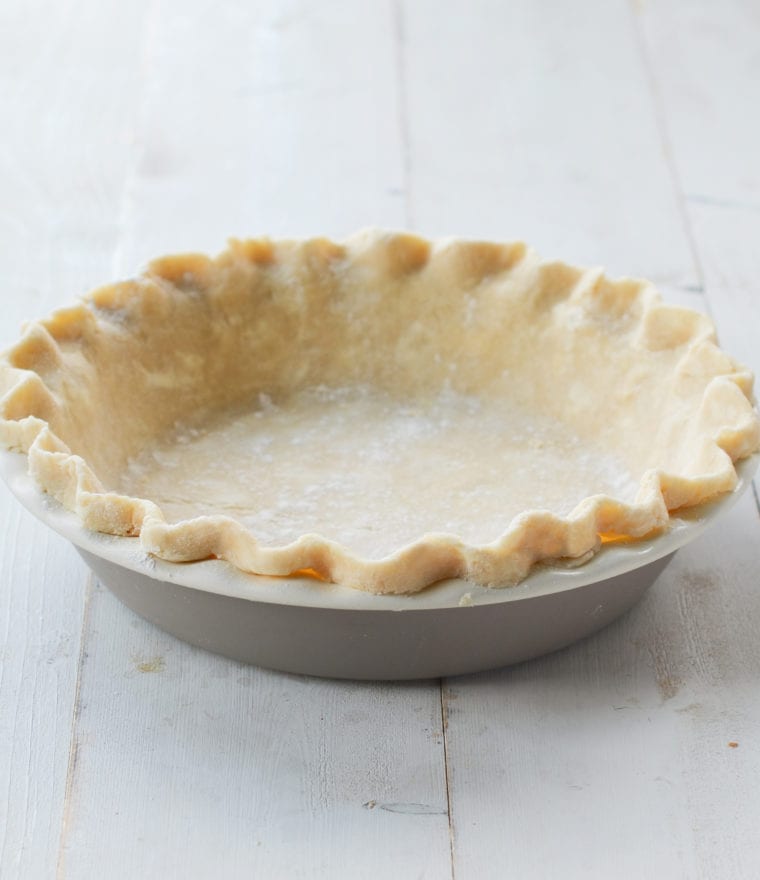
This is my go-to pie crust recipe. It has a buttery flavor and tender, flaky texture. The dough is relatively easy to work with and roll out, and it holds its shape in the oven. The secret lies in using a combination of butter and shortening; butter not only imparts a rich flavor but also contributes to the crust’s flakiness, while shortening ensures it maintains its shape and enhances the texture. Another key ingredient is a dash of baking powder, a genius tip from pastry chef Nick Malgieri, which helps the crust expand into the pan, preventing shrinking and slippage during baking. With just a few simple ingredients and these expert tips, even beginners can master a delicious pie crust at home.
“I’ve tried for many years to make a good pie crust. And here it is… the best ever. Thank you so much for sharing this recipe, and for explaining the baking process in such details. This will be my go-to for years to come!”
What You’ll Need To Make Pie Crust
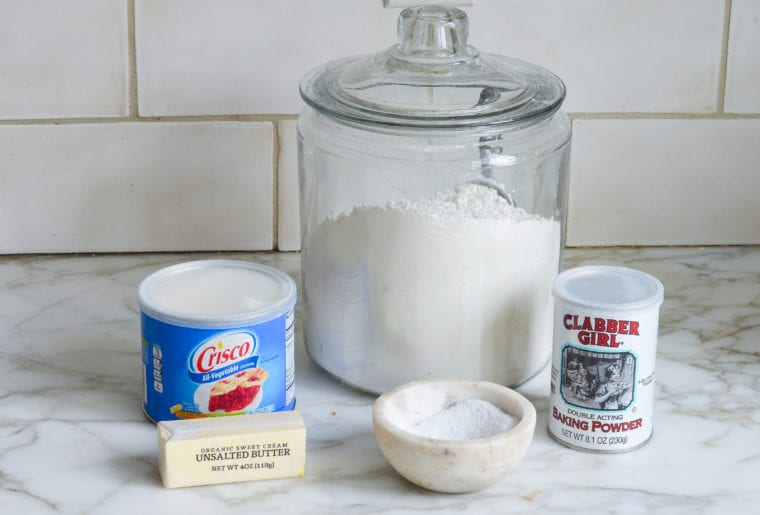
How to make pie crust
To begin, combine the flour, salt and baking powder in the bowl of a food processor fitted with the metal blade.
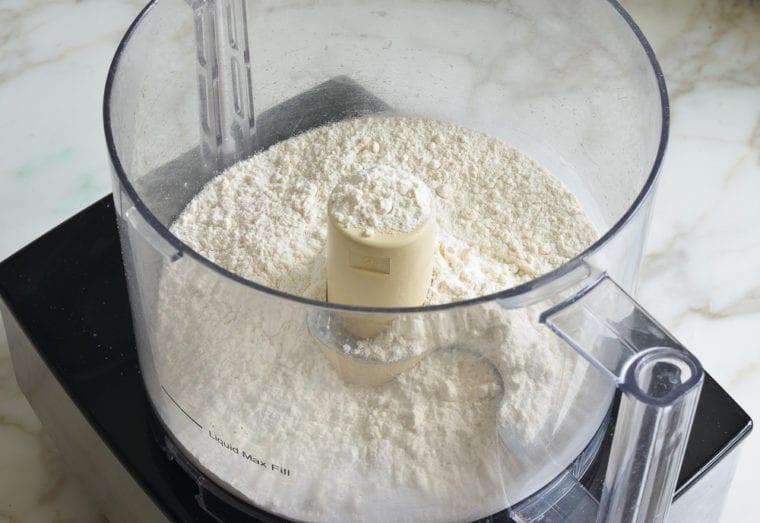
Add the cold butter and shortening in pieces.
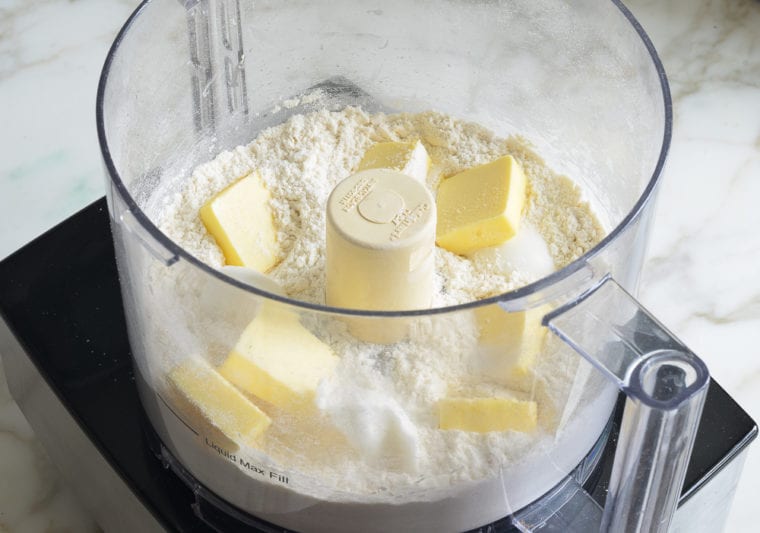
Pulse until you have coarse crumbs with lots of pea and chickpea-sized clumps of butter and shortening within. Don’t overprocess the dough: all of those clumps of fat steam in the oven, creating layers in the pastry that make a flaky crust.
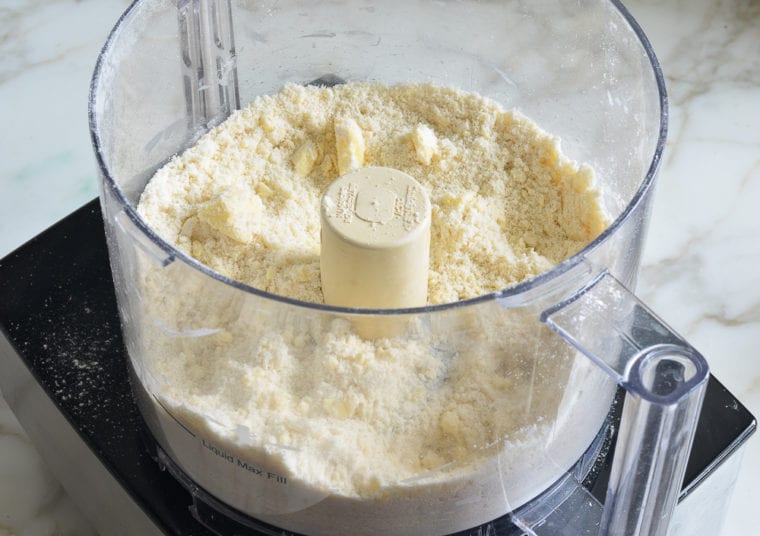
Add ice cold water and pulse a few times until the mixture is just evenly moistened and very crumbly. It will not come together into a mass — that’s good!
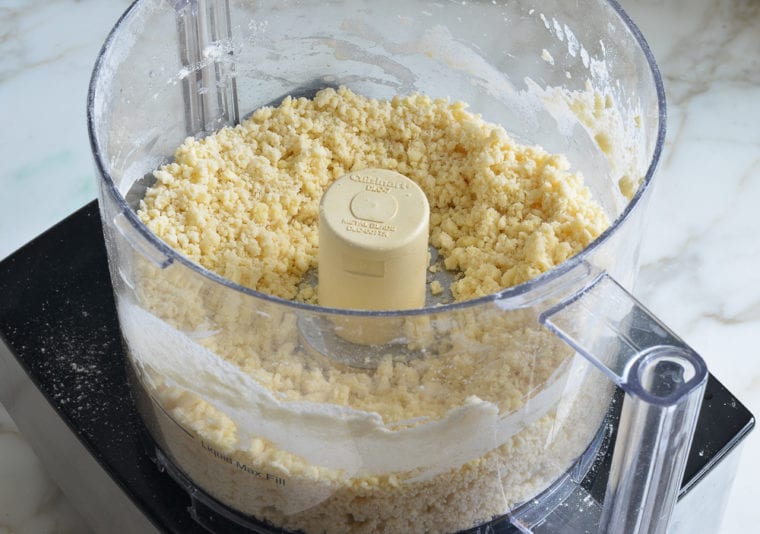
Dump the crumbly dough out onto a work surface. (I know this looks all wrong, but have faith!)
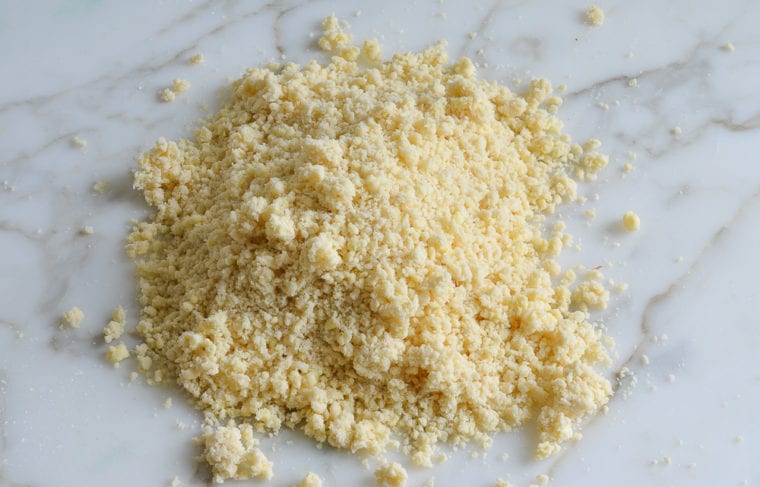
Gather it into a ball.
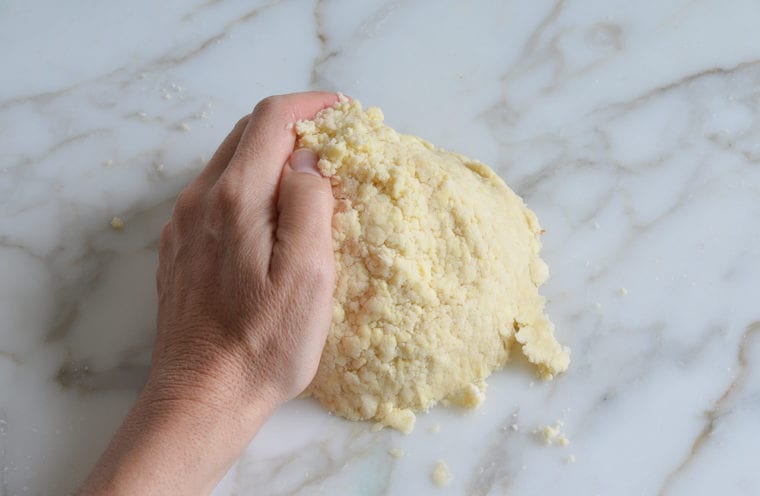
Then pat the dough into a 5-inch disc. Wrap it in plastic and refrigerate for at least 45 minutes or up to 3 days to rest. Allowing the dough to rest helps the gluten relax and also ensures that dough stays chilled — both important in making a tender, flaky crust.
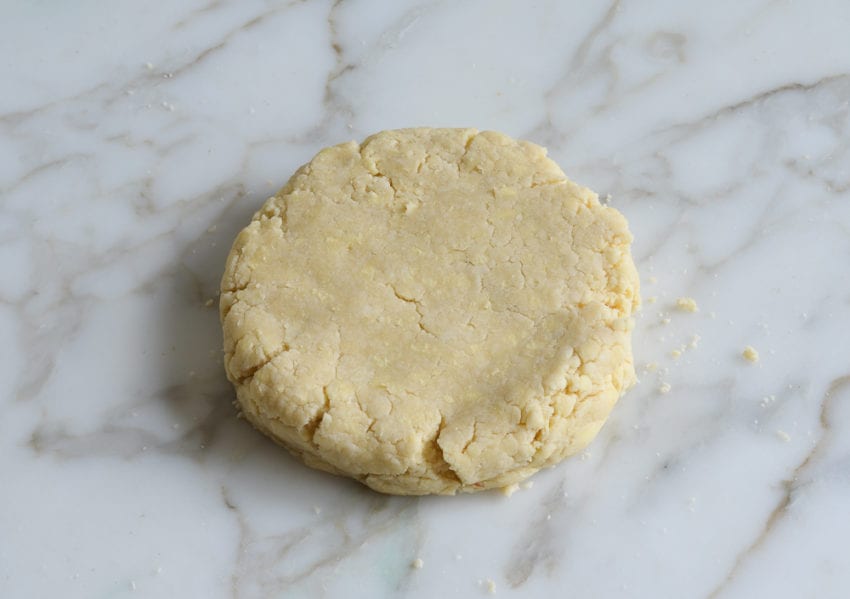
Take the dough out of the refrigerator and dust your work surface lightly with flour. Place the dough on top and sprinkle a little flour over the dough.
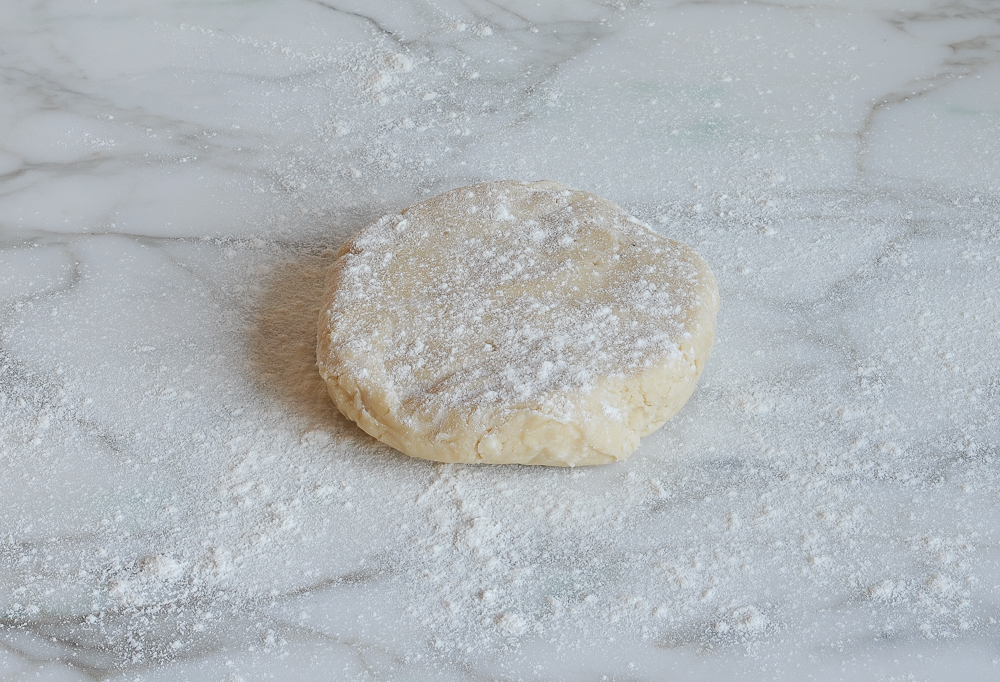
Use your hands to quickly knead the dough into a soft and malleable disc (don’t overwork it; you want it just supple enough to roll).
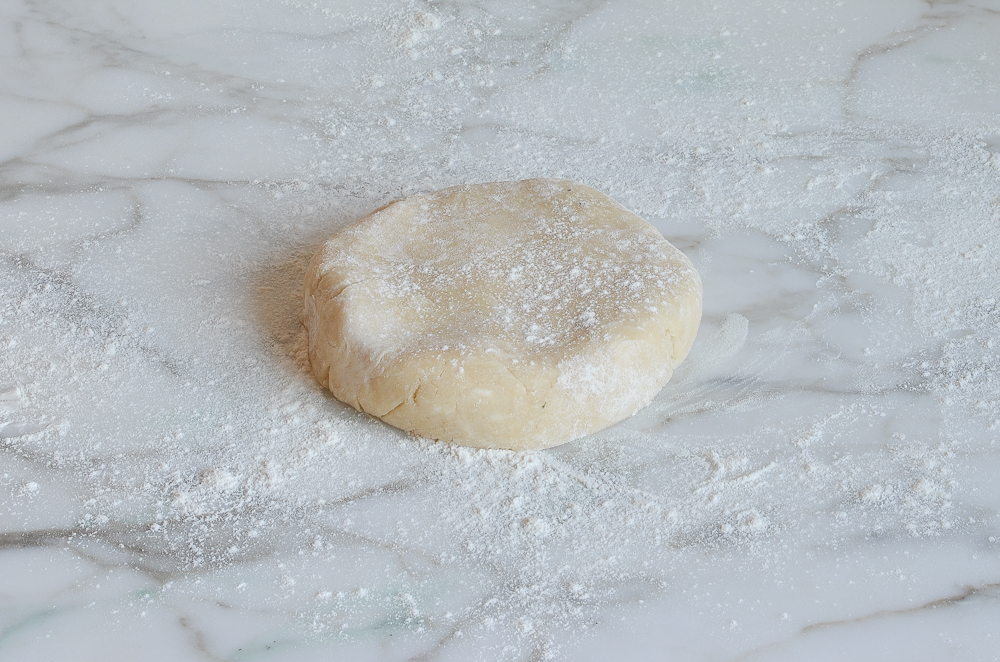
Roll the dough, turning it frequently and adding more flour as necessary so it doesn’t stick, into a 13-inch circle.
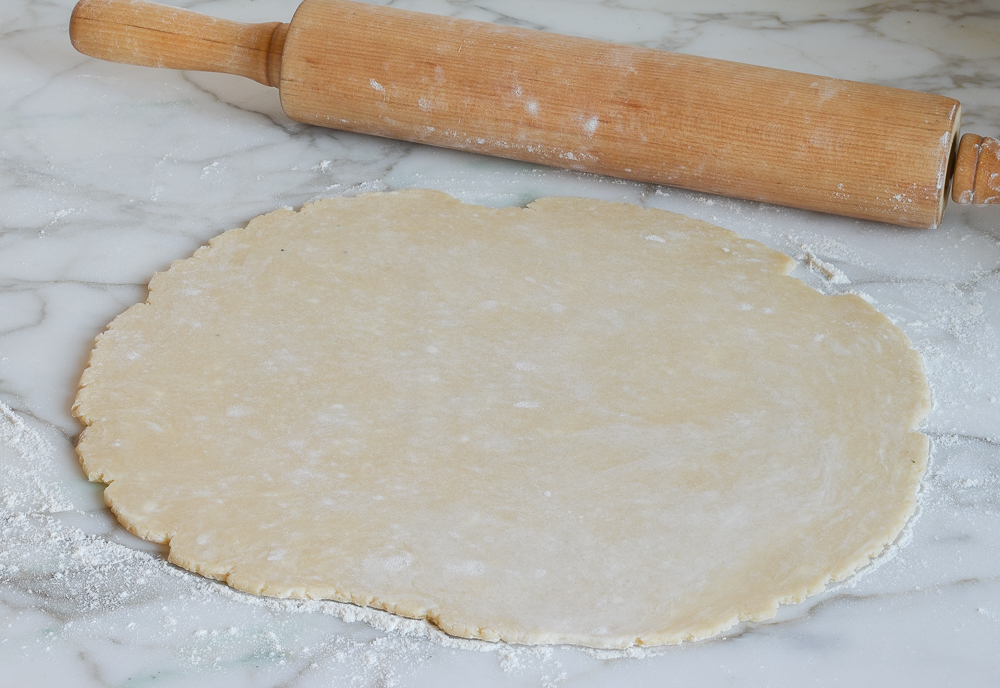
Fold the dough into quarters without creasing it and transfer it to a 9-inch deep-dish pie pan (the pan should be at least 1-1/2 inches deep).
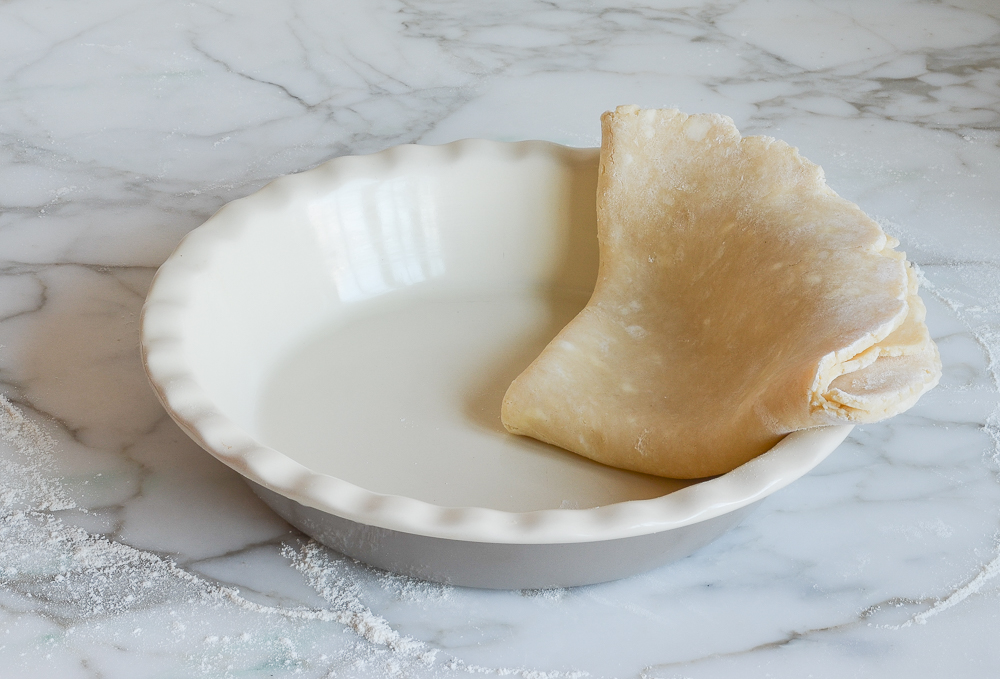
Gently fit the dough into the pan, easing it inwards rather than stretching it outwards. Don’t worry if it tears, just patch it right back up.
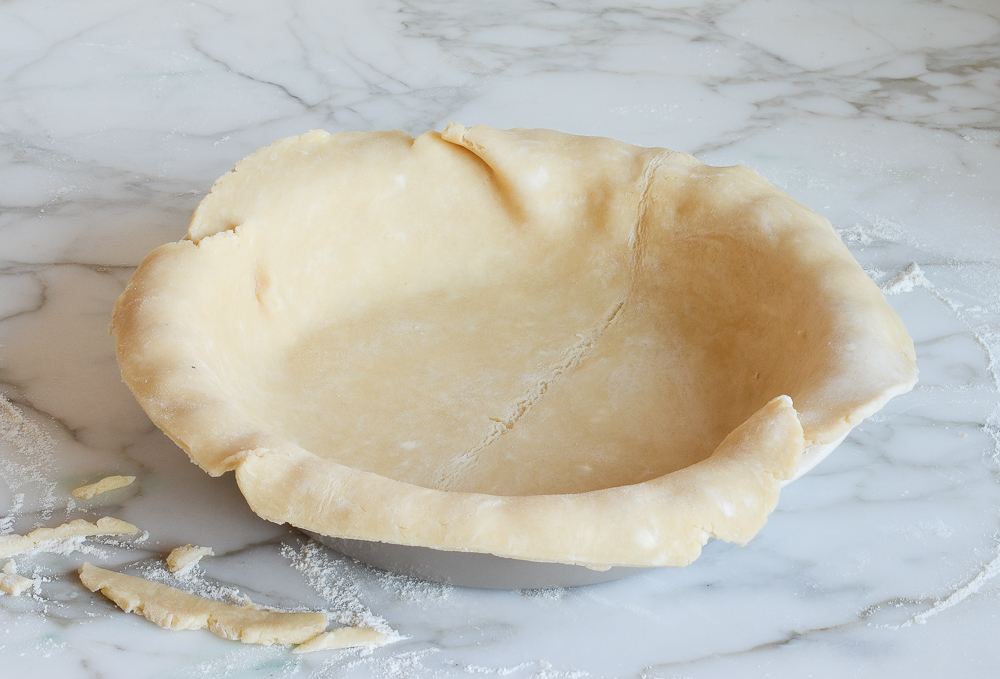
Trim the edges to 1/2-inch beyond the lip of the pie pan, if necessary. Turn the edges under to create a rim on the crust (you can use the scraps to patch in any thin areas); then press the rim against the lip of the pan, forming it into an even edge as you go. Using your fingers, crimp the rim.
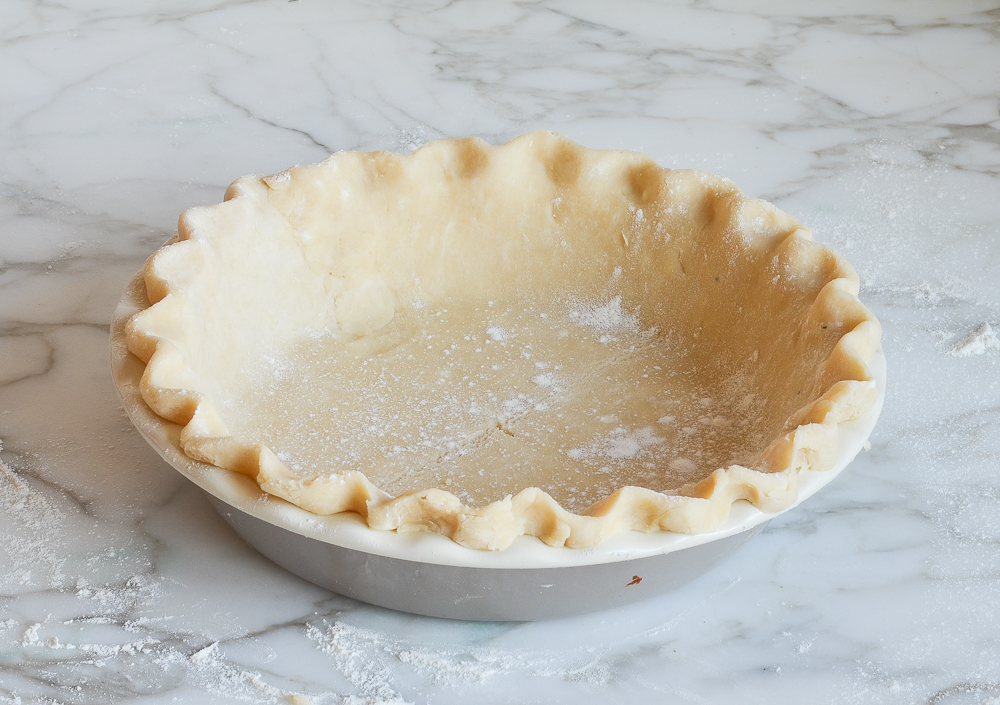
Place the crust in the refrigerator for at least 30 minutes before proceeding with your recipe.
If your crust requires blind baking: Preheat the oven to 375°F. Remove the crust from the refrigerator and cover with a piece of parchment paper. Fill the crust at least halfway full with dried beans or pie weights.
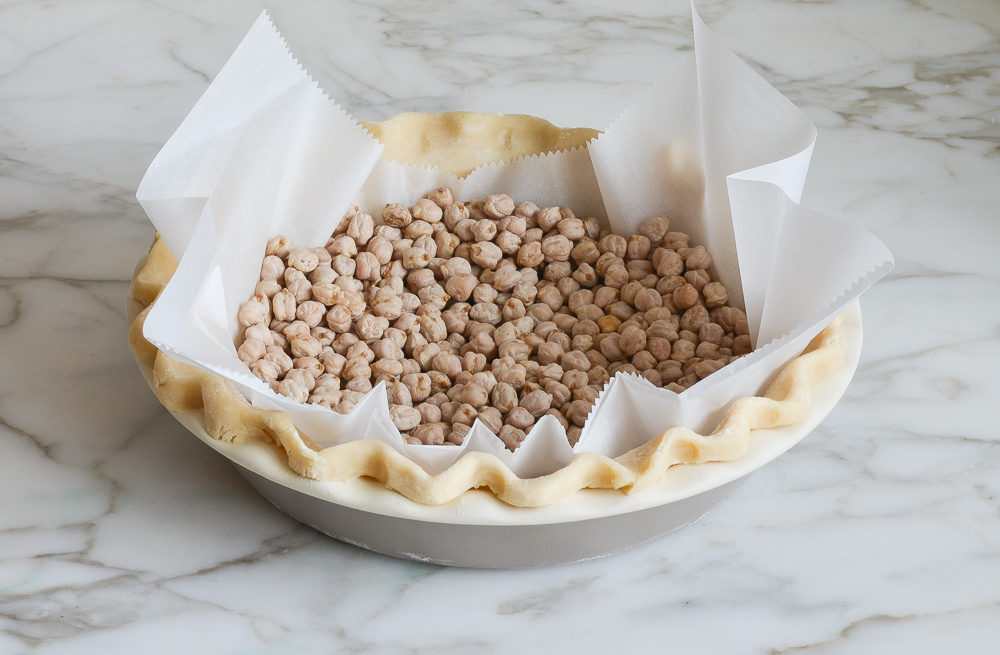
Bake for 15 to 20 minutes, or until the crust is pale and partially cooked. Remove the parchment and dried beans/pie weights and then proceed with your pie recipe.
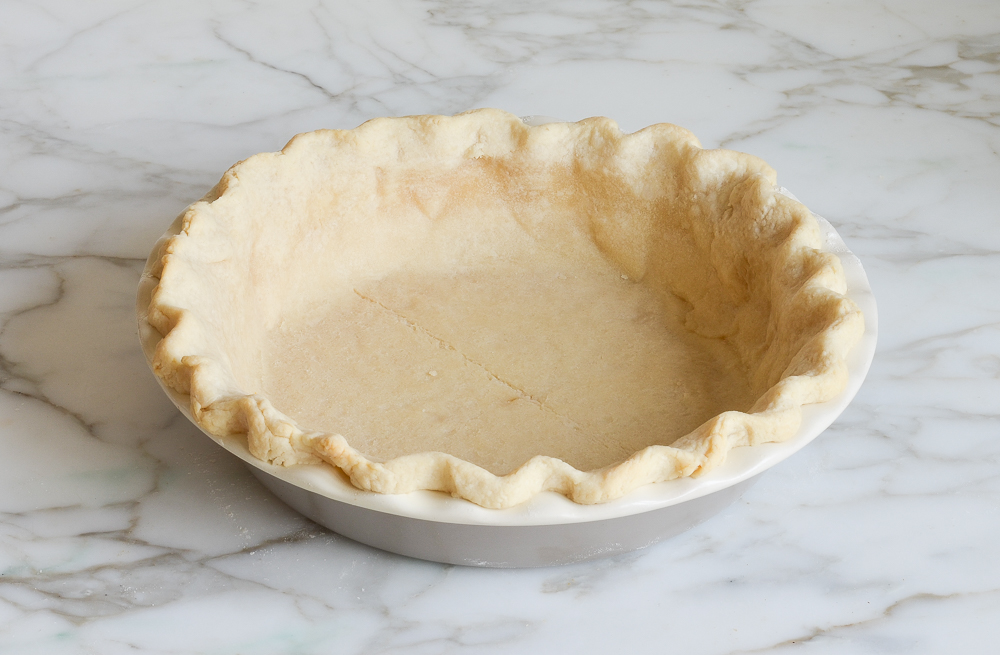
That’s all there is to it. Happy pie baking!
Frequently Asked Questions
A: Yes, you can use all butter or all shortening, but the texture and flavor will differ. All butter will give a richer flavor and potentially more flakiness due to its water content, but it can be harder to work with as it melts faster. All shortening, on the other hand, is easier to handle and helps the crust hold its shape better but will lack the delicious flavor that butter provides.
A: Absolutely! You can make pie crust ahead of time and refrigerate it for a few days or freeze it for longer storage. Wrap the dough tightly in plastic wrap before refrigerating or freezing. If frozen, thaw the dough in the refrigerator overnight before using. Making pie crust ahead can actually improve its texture and flavor as it allows the gluten in the flour to relax.
A: Keeping the butter and shortening cold is crucial for achieving a flaky pie crust. When cold, these fats don’t mix completely with the flour, creating small pockets in the dough. As the crust bakes, the fat pockets steam, resulting in the desired flakiness. Additionally, cold fats are less likely to be overworked into the dough, which can prevent the crust from becoming tough. Working with cold ingredients also makes the dough easier to handle and roll out.
Video Tutorial
You May Also Like
- Perfect Pumpkin Pie
- Baking Soda vs. Baking Powder
- Bourbon Pecan Pie
- Perfect Apple Pie
- Sweet Potato Pie
My Favorite Pie Crust Recipe
With this simple recipe, making a tender and flaky homemade pie crust is totally doable, even for beginners!
Ingredients
- 1½ cups all-purpose flour, spooned into measuring cup and leveled with a knife
- ½ teaspoon salt
- ⅛ teaspoon baking powder
- 6 tablespoons very cold unsalted butter, sliced into ¼-inch pieces
- 3 tablespoons very cold vegetable shortening, in 3 pieces
- 4 tablespoons very cold water
Instructions
- Combine the flour, salt and baking powder in the bowl of a food processor fitted with the metal blade. Process for 5 seconds to blend.
- Add the butter and shortening. Pulse until you have coarse crumbs with lots of pea-sized clumps of butter and shortening within, 15 to 20 one-second pulses.
- Add the water and pulse until the mixture is just evenly moistened and very crumbly, 7 to 10 one-second pulses.
- Dump the crumbly dough out onto a work surface and gather it into a ball.
- Pat the dough into a 5-inch disc and wrap it in plastic wrap. Refrigerate for at least 45 minutes or up to 3 days to rest.
- Take the dough out of the refrigerator and dust your work surface lightly with flour. Place the dough on top and sprinkle a little flour over the dough. Use your hands to quickly knead the dough into a soft and malleable disc (don’t overwork it; you want it just supple enough to roll).
- Roll the dough, turning it frequently and adding more flour as necessary so it doesn’t stick, into a 13-inch circle.
- Fold the dough into quarters without creasing it and transfer it to a 9-inch deep-dish pie pan.
- Gently fit the dough into the pan, easing it inwards rather than stretching it outwards. Don’t worry if it tears, just patch it right back up.
- Trim the edges to ½-inch beyond the lip of the pie pan, if necessary. Turn the edges under to create a rim on the crust (you can use the scraps to patch in any thin areas); then press the rim against the lip of the pan, forming it into an even edge as you go. Using your fingers, crimp the rim. Place the crust in the refrigerator for at least 30 minutes, and then proceed with your pie recipe.
- If your crust requires blind baking: Preheat the oven to 375°F. Remove the crust from the refrigerator and cover with a piece of parchment paper. Fill the crust at least halfway full with dried beans or pie weights. Bake for 15 to 20 minutes, or until the crust is pale and partially cooked. Remove the parchment and dried beans/pie weights and proceed with your pie recipe.
- Freezer-Friendly Instructions: The pie crust dough can be frozen for up to 3 months after you’ve formed it into a disc. Wrap it tightly in a layer of plastic wrap and a layer of foil. Before using, thaw the dough in the fridge overnight and then proceed with the recipe.
Nutrition Information
Powered by ![]()
- Per serving (10 servings)
- Calories: 163
- Fat: 11 g
- Saturated fat: 5 g
- Carbohydrates: 14 g
- Sugar: 0 g
- Fiber: 1 g
- Protein: 2 g
- Sodium: 72 mg
- Cholesterol: 18 mg
This website is written and produced for informational purposes only. I am not a certified nutritionist and the nutritional data on this site has not been evaluated or approved by a nutritionist or the Food and Drug Administration. Nutritional information is offered as a courtesy and should not be construed as a guarantee. The data is calculated through an online nutritional calculator, Edamam.com. Although I do my best to provide accurate nutritional information, these figures should be considered estimates only. Varying factors such as product types or brands purchased, natural fluctuations in fresh produce, and the way ingredients are processed change the effective nutritional information in any given recipe. Furthermore, different online calculators provide different results depending on their own nutrition fact sources and algorithms. To obtain the most accurate nutritional information in a given recipe, you should calculate the nutritional information with the actual ingredients used in your recipe, using your preferred nutrition calculator.

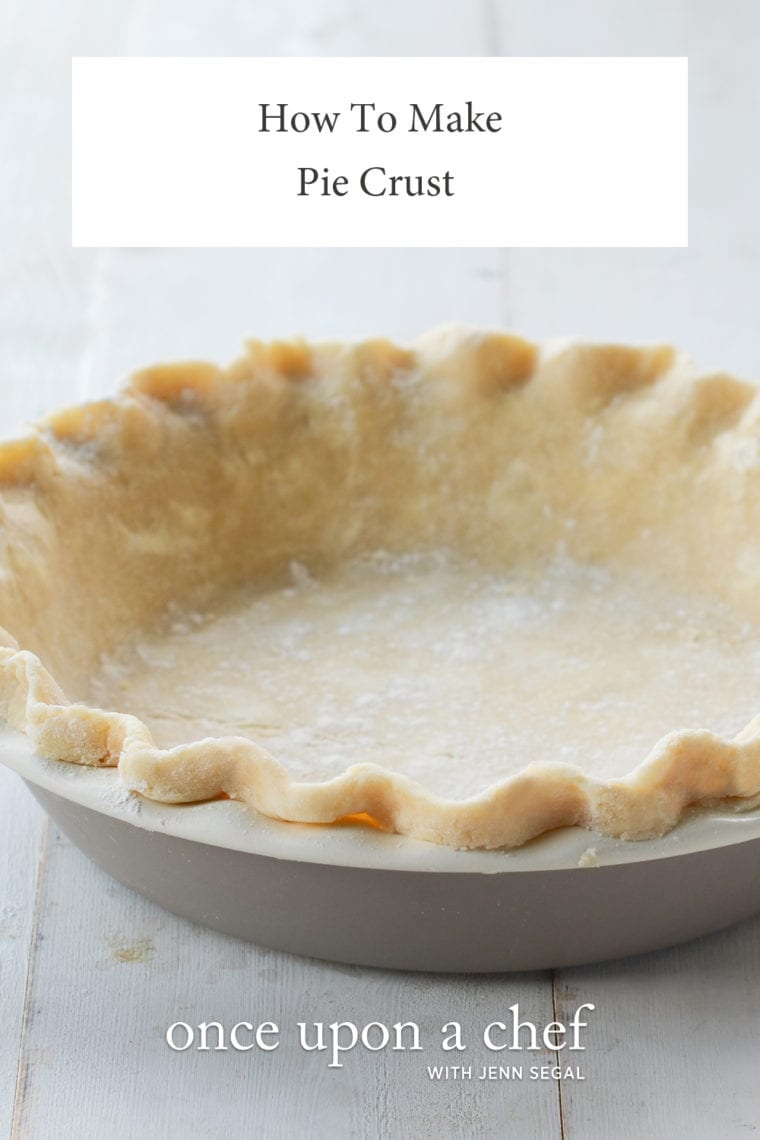
Jenn,
I haven’t tried this crust recipe yet but I’m giving 5 stars for now because 0 would unfairly bring the score down! Two questions:
1) Will it work to use lard in place of the shortening?
2) I’ve heard vinegar is a secret ingredient to great pie crust but I’ve never heard the reason why. Do you know?
Thank you for your fantastic site, I visit weekly (or more!) for recipe ideas and wonder how I ever managed to think of what to cook for dinner “BJ” (before Jenn). Your detailed instructions, cautions, pro tips and reasons-why are so helpful, and are well beyond any such content on other sites. You don’t just provide great recipes, you teach skills that make us all better, smarter cooks!
Hi Teresa, Thank you for your incredibly kind words about the recipes – so glad you enjoy them and find them easy to follow! Regarding the crust, it’s fine to use lard in place of the shortening. And while I’ve never used vinegar in a pie crust, it’s supposed to slow down gluten development and can make the crust a bit more tender, but I think the impact is minimal. Also, I believe it can help with browning.
Im not a very good cook. I used this recipe to make my first ever pie crust. ( I always just bought them now I’m in Spain and they don’t have them premade). It turned out great.
I would not recommend this recipe. I destroyed 3 pies. Dough is far too flaky and falls apart when trying to roll it.
Hi Jen,
I love your recipes and decided to make this pie crust for Thanksgiving pies. It was fine for your pumpkin pie recipe, but a disaster when I tried to make a lattice top for my cranberry-apple pie. The lattice strips lacked elasticity and broke as I was weaving them. What did I do wrong?
Hi Robin, Sorry you had trouble with the lattice strips. For more elasticity, you’ll need to work the dough a bit more. I would knead it a bit before rolling.
I am an expert pie crust maker. But thought I would try your recipe. I wondered what the point is of 1/8 tsp of baking powder. I’ve never seen this used in a pie dough recipe. I will say that using your food processor method was so very simple and quick. It’s chilling in the fridge and will roll it out tomorrow. Waiting to see how it rolls out. I always use a pastry cloth and rolling pin cover which is another trick to make rolling easier.
I lost my ‘go to’ pie crust recipe and tried this one out and it was an absolute disaster. I have been baking pies for years and this recipe is far, far, too dry. Even after adding extra ice water just to get the crumbs to stick together enough to form into a disc, after chilling and taking it out to roll into a crust it just crumbled all over again. Do not recommend.
Thankful for your recepies, Jenn. Happy Thanksgiving!
Hi Jenn,
Do you recommend using regular shortening or the butter flavor?
Hi Cathy, I use the regular.
I keep a file of pie dough recipes w my comments…. nerd alert…. I have tried about 18 over the years and since I don’t make pie often its always kind of scary to go to the trouble and then fail. ie too crumbly/cracking to roll out, oozing butter & awful shrinkage- Ive tried vodka, vinegar, different fats, differnet ratios. Techniques w all recipes saying this one is the easiest & BEST- “no-fail!”
Rubbish. This recipe I doubled and froze discs- made apple pie. NO SHRINKAGE! And fairly easy to roll out. So thank you for sharing the recipe.
Hi Jen
I asked a question and thought it took but I don’t see it. I’d like to make your pie crust recipe today and would like to know if I can use beef tallow in place of crisco? Also, if so would it be a one to one replacement?
Hi Paula, the flavor beef tallow lends is subtle, but I’d only use it if you are making a savory pie with the crust. And yes, it would be a 1 to 1 ratio.
Hi Jen
Can I replace the crisco with beef tallow? If so is it a one for one replacement?
Looking to make this this weekend hope you can respond asap. Thanks Paula
Hi Paula, Yes you can definitely make that substitution, and it’s a one-for-one replacement. Please LMK how it turns out!
This pie crust is my favorite too!
⭐️⭐️⭐️⭐️⭐️
This is the perfect pie crust. I’ve used it for both sweet and savory pies. Last night was chicken pot pie – I made 3 individual pies in the cutest little stoneware pie pans. I divided one crust recipe into 6 pieces, for the top and bottom of each. The crust was the star! Thanks!
Hi, Jenn,
I think I should commit to frozen or refrigerated crusts, only! I have tried many recipes over many years, and tonight tried this one as I have found your recipes to be delicious, with reliably good directions. I made it to use with your Parmesan-leek quiche, which we have enjoyed several times. I followed the crust recipe precisely, weighing the flour to be precise, using cold butter and shortening, and the recommended number of pulses with the food processor. I did add an extra Tbsp. of ice water. It wasn’t easy to form the dough into a disk, but after several minutes it went into the refrigerator, and it rolled with only small cracks. I blind-baked using the crust directions for time and temperature, which are different from the quiche directions (which call for a frozen crust). After blind baking, I saw standing melted butter in the bottom of the crust, but didn’t blot it. The quiche was set in the recommended cooking time (and SO tasty!) but the crust was doughy under the quiche. Is this recipe not recommended for a quiche? I have had excellent results with your galette crust, by the way, but with sugar in the crust it didn’t sound right for a quiche. Pie crust! I’ve always wanted to be able to make a reliably good crust, and I’ve been cooking and baking for 60 years. Just wondered if you know what I did wrong. Any advice is greatly appreciated!
And do you recommend the galette crust for “regular” pies, or only galette/tart-types?
Thank you for sharing your delicious recipes!
Hi Judy, I’m sorry you had a problem with the crust! I’ve never seen butter, pooling in the bottom of the crust; next time, I’d blend the ingredients a little more. And I suspect the crust was a little soggy because the quiche batter is so wet. I’d follow the blind baking instructions in this pumpkin pie recipe.
I haven’t tried the galette crust for regular pies; I think it would taste good, but I’m not sure how it would hold it’s shape.
Hi Jenn,
I want to try this recipe and wanted to know what brand of butter do you recommend? Also, just wanted to say I’m loving your recipes. I always feel confident knowing that whatever recipe I try is going to be amazing. Thanks! Rhonda from Round Rock, Texas.
Hi Rhonda, So glad you like the recipes and feel confident that they will come out well! 🙂
My go-to butter is Land O’Lakes unsalted. Hope you enjoy the pie crust!
Do we just double the recipe for a top crust,or are there any adjustments to be made? Making pot pie and want to use your recipe here.Thx
You’d just double the recipe. 🙂
Thanks I need to remember to use the cooking question box.
Love the way it turned out!
I am making this for the second time. I do find it very crumbly and you don’t realize how much until you turn it out to squeeze it together. Warm hands help with softening the butter a tad or an extra tablespoon of water whilst still in the processor. For those that want to use it for a sweet pie, I use the zest and juice of an orange as part of the liquid. The flavor is to die for.
I am making a sweet potato pie. Do i need to bake the crust prior to filling it? If so, how long and at what temperature
Hi Chris, yes, you’ll need to blind bake the crust for a sweet potato pie. Just follow the baking directions in this recipe.
I made this pie crust was easy enough. My issue was I left in refrigerated for about an hour and half. I worked it a little but it kept breaking apart. What did I do wrong.? I just patched crust together.
It sounds like it may have been a little dry. If you experience this again, try adding water, bit by bit until it gets to a workable texture.
I have struggled with insisting on making my own pie crust and hating the process. I have tried every recipe I run across and always end up having to piece my crust in frustration. This as a breeze! I’m so grateful to find The Right One! They’re all so similar and simple but this one just works. No more searching and putting pies crust off till the last minute. Thank you, Jen for all the hours of testing you put in to getting your recipes right. They are foolproof.
Hi Jenn, I accidentally over processed the dough. Should I just dump it and start over? Also, is it okay to use European butter or better to use American style? Thank you.
Hi Sally, I would start over. Sorry!!
Thanks Jenn, that’s what I thought but wanted to confirm. I’ve made it properly before and it is perfect.
Hi Jen,
Love this crust recipe with the pumpkin pie recipe! I’m making it again, but a friend is allergic to gluten. Is there an alternative for this crust to make it gluten-free that you know of?
Thank you!
Hi Kelsey, Glad you like the crust! I haven’t made this with gluten-free flour, so I can’t say for sure. but if you want to give it a try I know a lot of readers have had great luck baking with Cup4Cup and King Arthur’s all-purpose gluten-free flours. Please LMK how it turns out if you try it!
I love this recipe! For me it is foolproof. I always double it, and freeze one disc in a ziplock baggie. The dough is easy to work, the crust comes out flaky, every time. I used to use Pillsbury pie crust, but this is so simple and 10x’s tastier.
Will this recipe work using gluten free 1:1 all purpose flour?
Hi Susan, I’ve never made this with gluten-free flour so it’s hard to say for sure — I’m sorry! If you try it, I’d love to hear how it comes out. 🙂